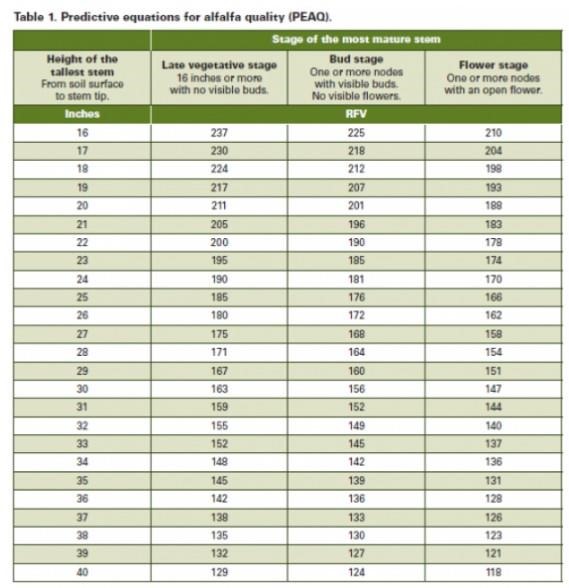Measuring the tallest stem in the sample area.
While PEAQ provides an estimate of RFV, adjustments need to be made for harvest loss. Even under the best harvest conditions, 10-20% of the forage dry matter can be lost at harvest. This amounts to approximately 15 RFV points for haylage and 25 RFV points for dry hay. Therefore, to end up with 150 RFV alfalfa, harvest the crop when PEAQ measurements estimate a RFV of 165 for a haylage harvest and 175 for a hay harvest. Additionally, consider weather forecasts and allowing for proper drying time when deciding when to harvest alfalfa.
Steps for using PEAQ to determine when to harvest first crop alfalfa
Step 1. Choose a representative two square foot area in the field.
Step 2. Determine the stage of the most mature stem as defined in Table 1.
Step 3. Measure the tallest stem in the area. The tallest stem may not be the most mature stem. Measure the stem from the soil surface to the tip of the stem; not to the tip of the leaf. Straighten the stem for an accurate height measurement. Based on stem maturity and stem height, use Table 1 to estimate the RFV of standing alfalfa crop.
Step 4. Repeat steps 1-3 in five representative areas across the field.
Step 5. To estimate harvest quality, subtract 15-25 RFV units to account for harvest losses during the haylage or hay harvest process, respectively.
Step 6. Determine optimum harvest time using the PEAQ estimate, livestock forage quality needs, considerations of upcoming weather forecasts favorable for harvest and drying, and the general assumption that RFV drops three to five points per day.
Iowa State University Extension and Outreach maintains a PEAQ website that includes a fact sheet to explain how to use the PEAQ method to determine when to harvest first crop alfalfa. This website also includes postings of PEAQ values from alfalfa fields across Iowa that are monitored by Iowa State University Extension and Outreach staff. Following these reports is helpful in tracking alfalfa development, but remember that crop conditions vary field-by-field. Therefore, it is recommended to take PEAQ measurements in your own field for the best assessment of when to harvest alfalfa for the optimum forage quality for your operation.

Source : iastate.edu